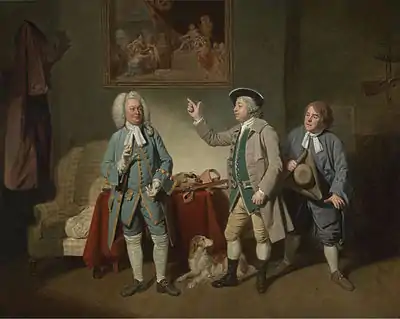Edward Shuter
Edward Shuter (c. 1728–1776) was an English actor.
_(14783355905).jpg.webp)
Edward Shuter, illustration from a book by Alwin Thaler (1922)

Edward Shuter as Justice Woodcock in "Love in a Village" by Isaac Bickerstaffe (Johann Zoffany, 1767)
Life
Shuter was born in London to poor parents. He made his first appearance on the London stage in 1745 in Cibber's Schoolboy. [1]
He made a great reputation in old men's parts. He was the original Justice Woodcock in Love in a Village (1762), Hardcastle in She Stoops to Conquer (1773), and Sir Anthony Absolute in The Rivals (1775).
He was buried in St. Paul's, Covent Garden.[2]
Portraits
His portrait as Scapin is in the Mathews collection in the Garrick Club; another portrait by Zoffany was engraved by Finlayson.[3]
References
- Chisholm 1911.
- Knight 1897.
- Knight, John Joseph (1897). . In Lee, Sidney (ed.). Dictionary of National Biography. 52. London: Smith, Elder & Co. pp. 172–174.
Attribution:
 This article incorporates text from a publication now in the public domain: Chisholm, Hugh, ed. (1911). "Shuter, Edward". Encyclopædia Britannica. 24 (11th ed.). Cambridge University Press. p. 1024.
This article incorporates text from a publication now in the public domain: Chisholm, Hugh, ed. (1911). "Shuter, Edward". Encyclopædia Britannica. 24 (11th ed.). Cambridge University Press. p. 1024.- Knight, John Joseph (1897). . In Lee, Sidney (ed.). Dictionary of National Biography. 52. London: Smith, Elder & Co. pp. 172–174. ; Endnotes:
- Genest's Account of the English Stage
- Doran's Annals of the Stage, ed. Lowe
- Davies's Dramatick Miscellanies
- Clark Russell's Representative Actors
- Dibdin's History of the Stage
- Boaden's Memoirs of Mrs. Siddons, and Life of Mrs. Jordan
- O'Keeffe's Recollections
- Garrick Correspondence
- Dramatic Mirror
- Thespian Dict.
- Georgian Era
- The Dramatic History of Master Edward, Miss Ann, Mr. Llwhuddwhydd, and others, the extraordinaries of these times. Collected from Zaphaniel's original papers, illustrated with copper-plates, London, 1743 [should be 1763], 12mo, a scarce work by G. A. Stevens, in imitation of Sterne's style, was aimed particularly at Shuter and Nancy Dawson; it was several times reprinted (Brit. Mus. Cat. 1785 and 1786).
External links
This article is issued from Wikipedia. The text is licensed under Creative Commons - Attribution - Sharealike. Additional terms may apply for the media files.